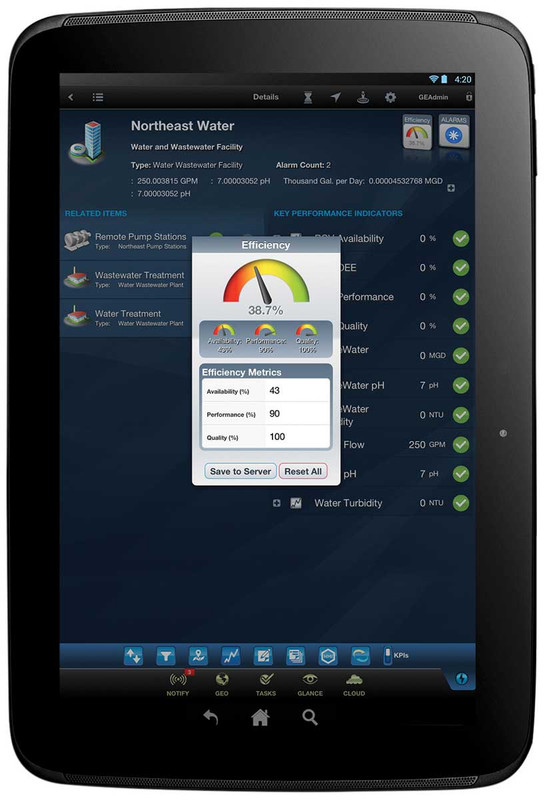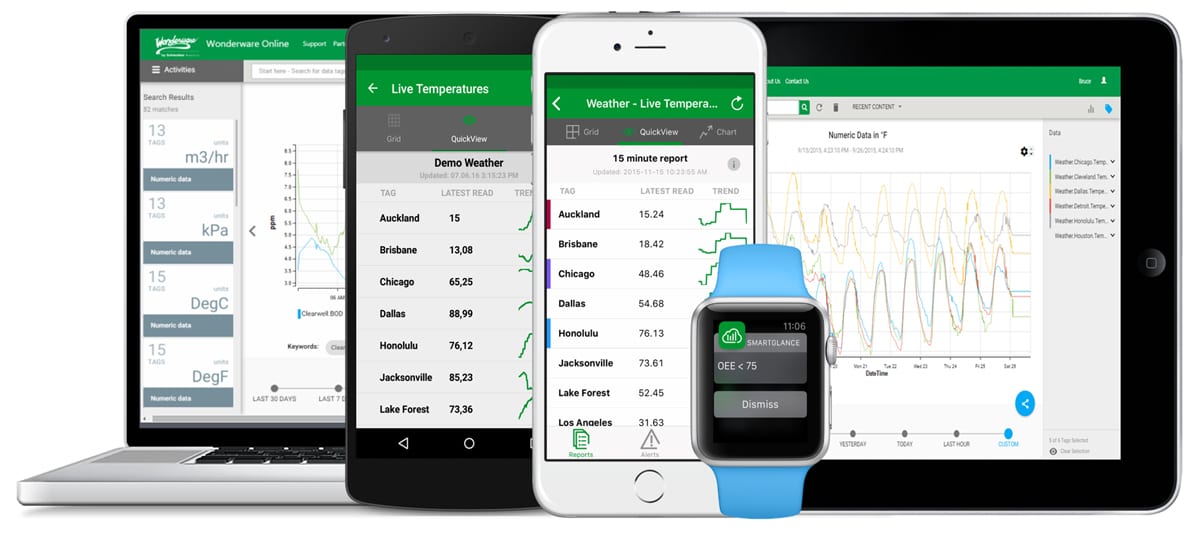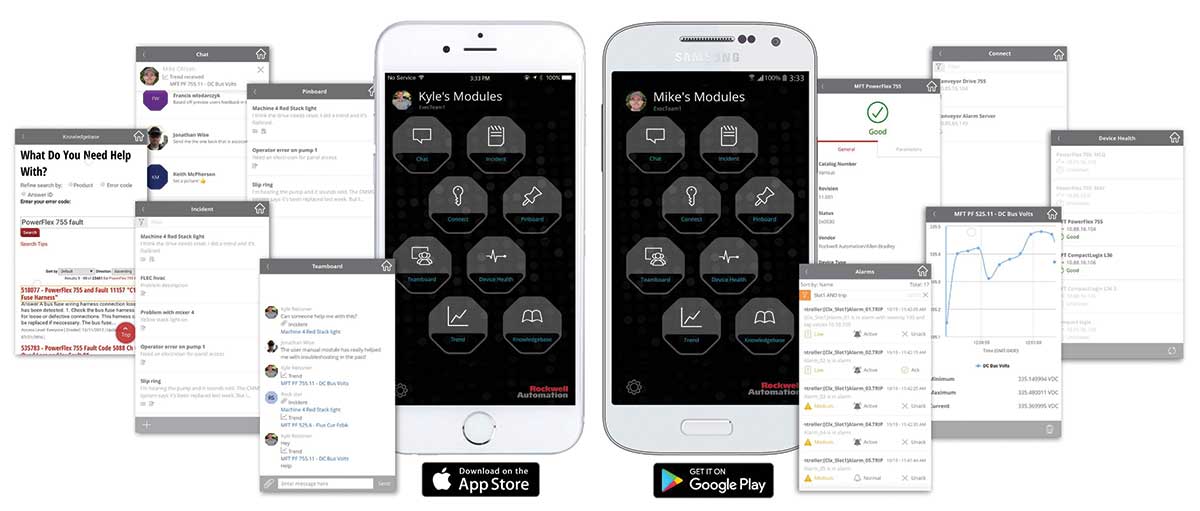When Chris Smalt receives a call for help at night, he does what has already become commonplace in the consumer space. He reaches for a mobile device—in his case, the iPad beside his bed. “I can see what the operator is up against and what the campus needs, and immediately help with troubleshooting and decision-making,” says the plant manager for the water, steam and power-generation facilities at Cornell University in Ithaca, N.Y.
He is able to do this because his iPad contains one of a new breed of industrial mobile apps that foster collaboration among operators, managers and remote experts. A number of automation vendors are borrowing and adapting features pioneered by consumer apps that have been thriving for years now on mobile devices.
At Cornell, Smalt’s facilities team is using Mobile, an app from GE Digital, to access key performance indicators (KPIs) at all hours. The app allows technical experts and managers to tap into Cornell’s GE Digital Historian and iFIX supervisory control and data acquisition (SCADA) system. Users pinch and zoom on the screen as they view data on electrical distribution, equipment status, power through breakers, and power contributed to or drawn from the grid. They also can receive and attach pictures, videos and comments.
Now, when an asset fails, operators can collaborate with remote experts to devise a workaround and bring systems back online quickly. Managers can also use power consumption and weather forecasts to make decisions that maximize the university’s twin goals of energy efficiency and environmental stewardship.
As a result of the Mobile app and other Internet-enabled technology from GE Digital, Cornell reports that after-hours troubleshooting is 40 percent faster and that reliability, uptime and energy savings have improved. The university plans to expand its use of Mobile with advanced alarm and analytics features.
Mimicking the feel of social media
One way industrial mobile apps are borrowing from their consumer counterparts is by mimicking social media in features like group collaboration, chat and threaded conversations. “With these social media tools, operators don’t have to rely on just the expertise that is available on the floor,” explains Ravi Subramanyan, senior product manager of Edge applications at GE Digital.
As powerful as social media-like tools promise to be, however, they cannot just be dropped into a manufacturing facility. To be effective, they must be adapted for the needs of the plant floor, according to Subramanyan. If group collaboration, for example, is going to be effective, then operators must be assured of access to experts who are not only right for the problem at hand, but also available when needed. A mechanism must exist to ensure that the experts will respond to posts in a timely manner.
Peter Zornio, chief strategic officer at Emerson Automation Solutions, agrees that social media features like chat, threaded conversations and sharing must be adapted for industrial use. “Apps like our AMS Asset View and DeltaV Mobile must bridge the intuitive experience of consumer-app design with communicating industrial process information in the way that users are used to seeing it,” he says.
For Zornio, the key to bridging these two different worlds is making users’ jobs easier. “This means integrating human-centered design best practices, making critical KPIs easy to access and understand, and leveraging progressive disclosure techniques to avoid information overload,” he offers. “When done right, mobile apps mean more productivity, safety and efficiency.”
Besides displaying a maintenance-and-reliability dashboard, Emerson’s AMS Asset View has a messaging function that includes threaded conversations and sharing. DeltaV Mobile also has sharing, as well as personalized watchlists and real-time alarm notices from the automation vendor’s distributed control system (DCS).
A Facebook for industry?
A chemical plant operated by Honeywell Specialty Materials is making the point with a Facebook-like collaboration feature on a mobile app developed by a sister division, Honeywell Process Solutions (HPS). Called Honeywell Pulse, this app alerts operators when fluctuations in process variables suggest that a seal is failing on a process producing a corrosive material. If the seal were to rupture, downtime for repair and cleanup would be about three hours, and the cost would be about $8,000.
“When we looked at the variables being monitored around these seals, we noticed that, almost every time before a rupture, certain variables start fluctuating wildly in a 40-minute window beforehand,” recalls Rohit Robinson, HPS’s director of emerging trends in mobility and Big Data. Now, when these fluctuations begin, the app automatically sends an alert to the smartphones of the appropriate technicians so they can divert the flow of material and replace the seal before a rupture occurs.
Pulse resembles Facebook and other social media in that it allows participants in an event to use their phones to post comments in an ongoing conversation. The app, however, differs from social media by tying each conversation to the plant’s workflows, thereby giving the collaboration much more structure. “You can’t just start a conversation about any topic that you might find interesting,” Robinson notes. Only events, such as the fluctuations at the Honeywell Specialty Materials plant, can initiate conversations.
Another important difference is that the collaboration is not ad hoc. Posts, for example, are limited to groups of specific subscribers from operations, maintenance and other organizations in the enterprise. Moreover, a few features ensure that an alert or request for help does not languish. Once an event is triggered and all subscribers in the group receive the alert, one of those subscribers can click on a Take Ownership function to take responsibility for the event. “The rest of the team can then go about their daily work, and management has a single point of contact for resolution,” Robinson says.
Honeywell Pulse also offers plants some opportunities to analyze their operations. “The alerts, collaboration postings, time to take ownership and so forth are being stored,” Robinson says. Management could then compare sites and ask questions like: Why does one site take 30 minutes before someone takes ownership, but another site takes only seven minutes?
Chat with your vendor
Schneider Electric Software uses live chat in a different way. Its Wonderware SmartGlance mobile app is aimed at promoting collaboration between the automation vendor and its user base. “We receive numerous spontaneous interactions with our customers covering everything from technical and commercial questions to conversations about our broader portfolio and direct feedback on the apps,” reports Saadi Kermani, technology evangelist and business development manager for Schneider’s Industrial Information Management business. “One click to a live person. One click to resolution.”
This cloud-hosted, native mobile app is available as a free download from app stores. “We’ve implemented chat exactly in the same way as a consumer offering would,” Kermani says.
At Seminole County’s Water Division in Florida, the focus has not been on chats, but on how SmartGlance allows operators and technicians at its water/wastewater facility to view the same data on their mobile devices. “We now have operational alerts, process reports, and both historical and real-time asset trends from our historian on any device,” says Russell Carpenter, technology coordinator.
The app also gives the facility’s chief operators the ability to monitor the progress of team members on completing their assigned tasks, an ability that boosts accountability. Technicians in the field, moreover, can generate their own set of personalized alerts for alarms that matter specifically to them. Rather than being overwhelmed by a barrage of alarms and data, they now receive a manageable set of information focused on their work.
Like many consumer apps, SmartGlance also allows users to provide additional contextual information as free-form text. “They can turn email addresses or phone numbers into actionable links that are recognizable by smartphones,” adds Kermani at Schneider Electric. “This enables them to launch a phone call or their email app natively and directly within the app.”
This is where the similarities to consumer apps end, however. SmartGlance sits on an architecture that has been hardened to secure what are essentially perimeterless networks. “Instead of connecting mobile devices directly to plant data sources, we put plant data sources on a singular, unidirectional and encrypted port to our secure cloud infrastructure and services,” Kermani says. “Then the mobile app connects in a read-only mode to our secure cloud, never needing to connect to the origin of the data.” Meanwhile, Schneider Electric applies security protocols on all connections.
Overcoming the obstacles
Although the continuing convergence of operations technology (OT) and information technology (IT) has certainly helped make mobile devices more practical in industrial settings, security and the plant environment still present important obstacles to their greater use. “An effective strategy for implementing the necessary plant-floor connectivity requires involving IT teams early and often, as well as adopting a multilayered security strategy,” says Zornio at Emerson. He recommends that the strategy include user and device authentication, device whitelisting, data encryption and appropriate IT mobile device management policies.
Zornio also advises users to pick mobile devices that meet their process, operational, safety and security requirements. “In some plant areas, specific hardened devices that are classified to withstand harsh environments are required by regulations,” he notes. “This may require creating an app that can run on a Class 1, Div. 2 device.”
Interference from equipment has been another important obstacle to greater use of mobile devices in manufacturing. To work around the limited connectivity in most plants, Rockwell Automation recently introduced FactoryTalk TeamONE, an industrial app that exploits the computing power in smartphones today. This Slack-like app contains a server and database that permit each module to perform their functions within the host device itself. “Fundamentally, we went to an offline, first-mesh architecture, rather than using a hub-and-spoke (client-server) architecture,” explains Kyle Reissner, mobility platform leader for Rockwell.
The result is that the app can function without being connected to the network. Its opportunistic synchronization engine receives and sends updates whenever a connection exists. Consequently, no matter the connectivity status, each member of the team of specialists on the case can still use nearly instantaneous incident and collaboration data while working with the others on resolving an incident.
To illustrate how this might work, Reissner gives an example of an incident involving a mixer during the previous shift. When the new shift begins, a technician standing beside the mixer can review the data and various posts on the actions already taken with that mixer, even though local interference makes wireless communications to the cloud impossible. “I can add more notes and pictures to that incident, and save it in TeamONE,” Reissner says. “Then, as soon as I step into an area where a connection is possible, the updates in my phone synchronize with the other team members.”
TeamONE’s built-in server and opportunistic engine offer more options for establishing communications. A manufacturing facility, for example, can create what Reissner calls islands of Wi-Fi in the plant by installing wireless switches inside the control cabinets of key pieces of equipment. Because such switches can broadcast a couple hundred feet, people who have the appropriate permissions can connect and exchange information directly with the devices when they are near a mixer or other piece of machinery equipped with a switch. The time, effort and money for setting up servers and gateways and connecting them to the cloud are unnecessary.
In both of these scenarios, the team members have information about the incident at their fingertips, and the app tells them whether they are looking at live data or cached information. The big exception is alarms. “Right now, the TeamONE Alarm module supports viewing only live alarms,” Reissner says. “We feel strongly that, if you don’t have a connection, we shouldn’t show you any alarms to avoid creating false impressions about the current status of a process.”




